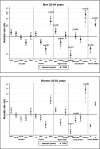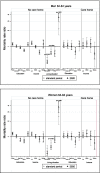Are we really all in this together? The social patterning of mortality during the first wave of the COVID-19 pandemic in Belgium
- PMID: 34922557
- PMCID: PMC8684273
- DOI: 10.1186/s12939-021-01594-0
Are we really all in this together? The social patterning of mortality during the first wave of the COVID-19 pandemic in Belgium
Abstract
Background: Belgium was one of the countries that was struck hard by COVID-19. Initially, the belief was that we were 'all in it together'. Emerging evidence showed however that deprived socioeconomic groups suffered disproportionally. Yet, few studies are available for Belgium. The main question addressed in this paper is whether excess mortality during the first COVID-19 wave followed a social gradient and whether the classic mortality gradient was reproduced.
Methods: We used nationwide individually linked data from the Belgian National Register and the Census 2011. Age-standardized all-cause mortality rates were calculated during the first COVID-19 wave in weeks 11-20 in 2020 and compared with the rates during weeks 11-20 in 2015-2019 to calculate absolute and relative excess mortality by socioeconomic and -demographic characteristics. For both periods, relative inequalities in total mortality between socioeconomic and -demographic groups were calculated using Poisson regression. Analyses were stratified by age, gender and care home residence.
Results: Excess mortality during the first COVID-19 wave was high in collective households, with care homes hit extremely hard by the pandemic. The social patterning of excess mortality was rather inconsistent and deviated from the usual gradient, mainly through higher mortality excesses among higher socioeconomic groups classes in specific age-sex groups. Overall, the first COVID-19 wave did not change the social patterning of mortality, however. Differences in relative inequalities between both periods were generally small and insignificant, except by household living arrangement.
Conclusion: The social patterning during the first COVID-19 wave was exceptional as excess mortality did not follow the classic lines of higher mortality in lower classes and patterns were not always consistent. Relative mortality inequalities did not change substantially during the first COVID-19 wave compared to the reference period.
Keywords: COVID-19; Inequalities; Mortality; Socioeconomic and socio-demographic patterning.
© 2021. The Author(s).
Conflict of interest statement
The authors declare that there are no competing interest.
Figures



Similar articles
-
A Nationwide Exploration of Social Inequalities in Cancer Mortality Amidst the COVID-19 Pandemic in Belgium.Cancer Med. 2025 Jan;14(1):e70487. doi: 10.1002/cam4.70487. Cancer Med. 2025. PMID: 39778068 Free PMC article.
-
A population-based study on mortality among Belgian immigrants during the first COVID-19 wave in Belgium. Can demographic and socioeconomic indicators explain differential mortality?SSM Popul Health. 2021 Apr 16;14:100797. doi: 10.1016/j.ssmph.2021.100797. eCollection 2021 Jun. SSM Popul Health. 2021. PMID: 33997246 Free PMC article.
-
Social health gradient and risk factors among patients hospitalized for COVID-19 and pre-pandemic respiratory infections. A linked national individual case-control study in Belgium.Front Public Health. 2024 Oct 28;12:1426898. doi: 10.3389/fpubh.2024.1426898. eCollection 2024. Front Public Health. 2024. PMID: 39529714 Free PMC article.
-
[SENTIERI - Epidemiological Study of Residents in National Priority Contaminated Sites. Sixth Report].Epidemiol Prev. 2023 Jan-Apr;47(1-2 Suppl 1):1-286. doi: 10.19191/EP23.1-2-S1.003. Epidemiol Prev. 2023. PMID: 36825373 Italian.
-
Incidence and mortality due to thromboembolic events during the COVID-19 pandemic: Multi-sourced population-based health records cohort study.Thromb Res. 2021 Jun;202:17-23. doi: 10.1016/j.thromres.2021.03.006. Epub 2021 Mar 8. Thromb Res. 2021. PMID: 33711754 Free PMC article.
Cited by
-
Association of socio-economic deprivation with COVID-19 incidence and fatality during the first wave of the pandemic in Italy: lessons learned from a local register-based study.Int J Health Geogr. 2023 May 4;22(1):10. doi: 10.1186/s12942-023-00332-9. Int J Health Geogr. 2023. PMID: 37143110 Free PMC article.
-
Area and individual level analyses of demographic and socio-economic disparities in COVID-19 vaccination uptake in Belgium.Vaccine X. 2024 May 3;18:100496. doi: 10.1016/j.jvacx.2024.100496. eCollection 2024 Jun. Vaccine X. 2024. PMID: 38779406 Free PMC article.
-
A new framework for disentangling different components of excess mortality applied to Dutch care home residents during Covid-19.BMC Med Res Methodol. 2025 May 10;25(1):126. doi: 10.1186/s12874-025-02579-1. BMC Med Res Methodol. 2025. PMID: 40348947 Free PMC article.
-
Did the socioeconomic inequalities in avoidable and unavoidable mortality worsen during the first year of the COVID-19 pandemic in Korea?Epidemiol Health. 2023;45:e2023072. doi: 10.4178/epih.e2023072. Epub 2023 Aug 3. Epidemiol Health. 2023. PMID: 37591788 Free PMC article.
-
Understanding excess mortality during COVID in Belgium: the influence of pre-existing health status and social factors.Arch Public Health. 2025 Jan 23;83(1):18. doi: 10.1186/s13690-025-01499-2. Arch Public Health. 2025. PMID: 39844284 Free PMC article.
References
-
- SkyNews. Virus does not discriminate claims Gove [Conservative government Minister for the Cabinet Office, UK]. https://news.sky.com/video/coronavirus-virus-does-not-discriminate-gove-.... Accessed 22 Apr 2020.
-
- Terrisse M. Un faubourg du Havre: Ingouville. Population. 1961;16(2):285–300. doi: 10.2307/1526527. - DOI
-
- Sharlin A. Methods for estimating population total, age distribution and vital rates in family reconstitution studies. Pop Stud. 1978. 10.1080/00324728.1978.10412811. - PubMed
-
- Desplanques G. L'inégalité sociale devant la mort. Econ Stat. 1984;162:29–50. - PubMed
Publication types
MeSH terms
LinkOut - more resources
Full Text Sources
Medical

